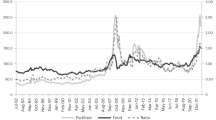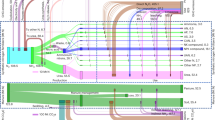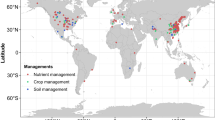Abstract
Nitrogen losses in agricultural systems can be reduced through enhanced-efficiency fertilizers (EEFs), which control the physicochemical release from fertilizers and biological nitrogen transformations in soils. The adoption of EEFs by farmers requires evidence of consistent performance across soils, crops and climates, paired with information on the economic advantages. Here we show that the benefits of EEFs due to avoided social costs of nitrogen pollution considerably outweigh their costs—and must be incorporated in fertilizer policies. We outline new approaches to the design of EEFs using enzyme inhibitors with modifiable chemical structures and engineered, biodegradable coatings that respond to plant rhizosphere signalling molecules.
This is a preview of subscription content, access via your institution
Access options
Access Nature and 54 other Nature Portfolio journals
Get Nature+, our best-value online-access subscription
$29.99 / 30 days
cancel any time
Subscribe to this journal
Receive 12 digital issues and online access to articles
$119.00 per year
only $9.92 per issue
Buy this article
- Purchase on Springer Link
- Instant access to full article PDF
Prices may be subject to local taxes which are calculated during checkout



Similar content being viewed by others
Data availability
Data included are already published and publicly available, with those publications properly cited in the reference list.
References
Searchinger, T. et al. Creating a Sustainable Food Future—A Menu of Solutions to Feed Nearly 10 Billion People by 2050 (World Resources Institute, 2018).
Erisman, J. W., Sutton, M. A., Galloway, J., Klimont, Z. & Winiwarter, W. How a century of ammonia synthesis changed the world. Nat. Geosci. 1, 636–639 (2008).
Zhang, X. et al. Managing nitrogen for sustainable development. Nature 528, 51–59 (2015).
Galloway, J. et al. Transformation of the nitrogen cycle: recent trends, questions, and potential solutions. Science 320, 889–892 (2008).
Sutton, M. A. et al. Too much of a good thing. Nature 472, 159–161 (2011).
Soons, M. B. et al. Nitrogen effects on plant species richness in herbaceous communities are more widespread and stronger than those of phosphorus. Biol. Conserv. 212, 390–397 (2017).
Erisman, J. W. et al. Consequences of human modification of the global nitrogen cycle. Phil. Trans. R. Soc. B 368, 20130116 (2013).
Johnston, A. M. & Bruulsema, T. W. 4R nutrient stewardship for improved nutrient use efficiency. Proc. Eng. 83, 365–370 (2014).
Cantarella, H., Otto, R., Soares, J. R. & de Brito Silva, A. G. Agronomic efficiency of NBPT as a urease inhibitor: a review. J. Adv. Res. 13, 19–27 (2018).
Hu, H.-W., Chen, D. & He, J.-Z. Microbial regulation of terrestrial nitrous oxide formation: understanding the biological pathways for prediction of emission rates. FEMS Microbiol. Rev. 39, 729–749 (2015).
Trenkel, M. E. Slow- and Controlled-Release and Stabilized Fertilizers: An Option for Enhancing Nutrient Efficiency in Agriculture (International Fertilizer Industry Association, 2010).
Li, T. et al. Enhanced-efficiency fertilizers are not a panacea for resolving the nitrogen problem. Glob. Change Biol. 24, e511–e521 (2018).
Zerulla, W. et al. 3,4-Dimethylpyrazole phosphate (DMPP)—a new nitrification inhibitor for agriculture and horticulture. Biol. Fertil. Soils 34, 79–84 (2001).
Azeem, B., KuShaari, K., Man, Z. B., Basit, A. & Thanh, T. H. Review on materials & methods to produce controlled release coated urea fertilizer. J. Control. Release 181, 11–21 (2014).
Dimkpa, C. O., Fugice, J., Singh, U. & Lewis, T. D. Development of fertilizers for enhanced nitrogen use efficiency–trends and perspectives. Sci. Total Environ. 731, 139113 (2020).
Dillon, J. L. & Anderson, J. R. The Analysis of Response in Crop and Livestock Production 3rd edn (Pergamon, 1990).
Keeler, B. L. et al. The social costs of nitrogen. Sci. Adv. 2, e1600219 (2016).
Sobota, D. J., Compton, J. E., McCrackin, M. L. & Singh, S. Cost of reactive nitrogen release from human activities to the environment in the United States. Environ. Res. Lett. 10, 025006 (2015).
Sutton, M. A. et al. Our Nutrient World: The Challenge to Produce More Food and Energy with Less Pollution (Centre for Ecology and Hydrology, 2013)
van Grinsven, H. J. et al. Costs and benefits of nitrogen for Europe and implications for mitigation. Environ. Sci. Technol. 47, 3571–3579 (2013).
Beeckman, F., Motte, H. & Beeckman, T. Nitrification in agricultural soils: impact, actors and mitigation. Curr. Opin. Biotechnol. 50, 166–173 (2018).
Hughes, J. P., Rees, S., Kalindjian, S. B. & Philpott, K. L. Principles of early drug discovery. Br. J. Pharmacol. 162, 1239–1249 (2011).
Blessy, M., Patel, R. D., Prajapaty, P. N. & Agrawal, Y. K. Development of forced degradation and stability of drugs–a review. J. Pharmaceut. Anal. 4, 159–165 (2014).
Ferreira, L. G., Dos Santos, R. N., Oliva, G. & Andricopulo, A. D. Molecular docking and structure-based drug design strategies. Molecules 20, 13384–13421 (2015).
Rego, Y. F. et al. A review on the development of urease inhibitors as antimicrobial agents against pathogenic bacteria. J. Adv. Res. 13, 69–100 (2018).
Domínguez, M. J. et al. Design, synthesis, and biological evaluation of phosphoramide derivatives as urease inhibitors. J. Agric. Food Chem. 56, 3721–3731 (2008).
Brito, T. O. et al. Design, syntheses and evaluation of benzoylthioureas as urease inhibitors of agricultural interest. RSC Adv. 5, 44507–44515 (2015).
Torralbo, F. et al. Dimethyl pyrazol-based nitrification inhibitors effect on nitrifying and denitrifying bacteria to mitigate N2O emission. Sci Rep. 7, 13810 (2017).
Irigoyen, I., Muro, J., Azpilikueta, M., Aparicio-Tejo, P. & Lamsfus, C. Ammonium oxidation kinetics in the presence of nitrification inhibitors DCD and DMPP at various temperatures. Aust. J. Soil Res. 41, 1177–1183 (2003).
Doran, G. S., Condon, J. R. & Kaveney, B. F. Rapid analysis of the nitrification inhibitor 3,4-dimethylpyrazole phosphate in soil using LC-MS/MS. Int. J. Environ. Analyt. Chem. 98, 606–621 (2018).
Sidhu, P., Taggert, B. I., Chen, D. & Wille, U. Degradation of the nitrification inhibitor 3,4-dimethylpyrazole phosphate (DMPP) in soils: indication of chemical pathways. ACS Agric. Sci. Technol. 1, 540–549 (2021).
McCarty, G. Modes of action of nitrification inhibitors. Biol. Fertil. Soils 29, 1–9 (1999).
Taggert, B. I., Walker, C., Chen, D. & Wille, U. Substituted 1,2,3-triazoles: a new class of nitrification inhibitors. Sci Rep. 11, 14980 (2021).
Schmücker, C., Stevens, G. W. & Mumford, K. A. Liquid marble formation and solvent vapor treatment of the biodegradable polymers polylactic acid and polycaprolactone. J. Colloid Interf. Sci. 514, 349–356 (2018).
Shen, Y., Du, C., Zhou, J. & Ma, F. Application of nano Fe III–tannic acid complexes in modifying aqueous acrylic latex for controlled-release coated urea. J. Agric. Food Chem. 65, 1030–1036 (2017).
Aussillous, P. & Quéré, D. Liquid marbles. Nature 411, 924–927 (2001).
Fujii, S., Yusa, S. & Nakamura, Y. Stimuli-responsive liquid marbles: controlling structure, shape, stability, and motion. Adv. Funct. Mater. 26, 7206–7223 (2016).
Macabuhay, A. et al. Modulators or facilitators? Roles of lipids in plant root-microbe interactions. Trends Plant Sci. 27, 180–190 (2022).
Monreal, C. M. in Labile Organic Matter—Chemical Compositions, Function, and Significance in Soil and the Environment Special Publication 62 (eds He, Z. & Wu, F.) Ch. 9 (Soil Science Society of America, 2015).
Yeoh, Y. K. et al. Evolutionary conservation of a core root microbiome across plant phyla along a tropical soil chronosequence. Nat. Commun. 8, 215 (2017).
Xiong, C. et al. Host selection shapes crop microbiome assembly and network complexity. New Phytol. 229, 1091–1104 (2020).
Toju, H. et al. Core microbiomes for sustainable agroecosystems. Nat. Plants 4, 247–257 (2018).
Trivedi, P., Mattupalli, C., Eversole, K. & Leach, J. E. Enabling sustainable agriculture through understanding and enhancement of microbiomes. New Phytol. 230, 2129–2147 (2021).
Trivedi, P., Leach, J. E., Tringe, S. G., Sa, T. & Singh, B. K. Plant-microbiome interactions: from community assembly to plant health. Nat. Rev. Microbiol. 18, 607–621 (2020).
Kim, J. & Buell, C. R. A revolution in plant metabolism: genome-enabled pathway discovery. Plant Physiol. 169, 1532–1539 (2015).
de Vries, F. T., Griffiths, R. I., Knight, C. G., Nicolitch, O. & Williams, A. Harnessing rhizosphere microbiomes for drought-resilient crop production. Science 368, 270–274 (2020).
Braguy, J. & Zurbriggen, M. D. Synthetic strategies for plant signalling studies: molecular toolbox and orthogonal platforms. Plant J. 87, 118–138 (2016).
Fitzpatrick, C. R. et al. The plant microbiome: from ecology to reductionism and beyond. Ann. Rev. Microbiol. 74, 81–100 (2020).
Gent, L. & Forde, B. G. How do plants sense their nitrogen status? J. Exp. Bot. 68, 2531–2539 (2017).
Sun, C.-H., Yu, J.-Q. & Hu, D.-G. Nitrate: a crucial signal during lateral roots development. Front. Plant Sci. 8, 485 (2017).
Canarini, A., Merchant, C. K. A., Richter, A. & Wanek, W. Root exudation of primary metabolites: mechanisms and their roles in plant responses to environmental stimuli. Front. Plant Sci. 10, 157 (2019).
Coskun, D., Britto, D. T., Shi, W. & Kronzucker, H. J. Nitrogen transformations in modern agriculture and the role of biological nitrification inhibition. Nat. Plants 3, 17074 (2017).
Zhang, X. N., Lu, Y. F., Yang, T., Kronzucker, H. J. & Shi, W. M. Factors influencing the release of the biological nitrification inhibitor 1,9-decanediol from rice (Oryza sativa L.) roots. Plant Soil 436, 253–265 (2019).
Voges, M. J., Bai, Y., Schulze-Lefert, P. & Sattely, E. S. Plant-derived coumarins shape the composition of an Arabidopsis synthetic root microbiome. Proc. Natl Acad. Sci. USA 116, 12558–12565 (2019).
Wang, J. & Chai, J. Structural insights into the plant immune receptors PRRs and NLRs. Plant Physiol. 182, 1566–1581 (2020).
Xia, L. et al. Can knowledge-based N management produce more staple grain with lower greenhouse gas emission and reactive nitrogen pollution? A meta-analysis. Glob. Change Biol. 23, 1917–1925 (2017).
Baumgart-Getz, A., Prokopy, L. S. & Floress, K. Why farmers adopt best management practice in the United States: a meta-analysis of the adoption literature. J. Environ. Manage. 96, 17–25 (2012).
Hasler, K., Bröring, S., Omta, O. W. F. & Olfs, H. Eco-innovations in the German fertilizer supply chain: impact on the carbon footprint of fertilizers. Plant Soil Environ. 63, 531–544 (2017).
Qiao, C. et al. How inhibiting nitrification affects nitrogen cycle and reduces environmental impacts of anthropogenic nitrogen input. Glob. Change Biol. 21, 1249–1257 (2015).
Kanter, D. R., Chodos, O., Nordland, O., Rutigliano, M. & Winiwarter, W. Gaps and opportunities in nitrogen pollution policies around the world. Nat. Sustain. 3, 956–963 (2020).
Feeding Africa’s Soils: Fertilizers to Support Africa’s Agricultural Transformation (Alliance for a Green Revolution in Africa, 2019).
Kanter, D. R. et al. Nitrogen pollution policy beyond the farm. Nat. Food 1, 27–32 (2020).
Gu, B. et al. A credit system to solve agricultural nitrogen pollution. Innovation 2, 100079 (2021).
Leach, A. M. et al. Environmental impact food labels combining carbon, nitrogen, and water footprints. Food Policy 61, 213–223 (2016).
Akiyama, H., Yan, X. & Yagi, K. Evaluation of effectiveness of enhanced-efficiency fertilizers as mitigation options for N2O and NO emissions from agricultural soils: meta-analysis. Glob. Change Biol. 16, 1837–1846 (2010).
Cai, Y. & Akiyama, H. Effects of inhibitors and biochar on nitrous oxide emissions, nitrate leaching, and plant nitrogen uptake from urine patches of grazing animals on grasslands: a meta-analysis. Soil Sci. Plant Nutr. 63, 405–414 (2017).
Decock, C. Mitigating nitrous oxide emissions from corn cropping systems in the Midwestern U.S.: potential and data gaps. Environ. Sci. Technol. 48, 4247–4256 (2014).
Feng, J. et al. Integrated assessment of the impact of enhanced-efficiency nitrogen fertilizer on N2O emission and crop yield. Agric. Ecosyst. Environ. 231, 218–228 (2016).
Gao, J. et al. Benefits and risks for the environment and crop production with application of nitrification inhibitors in China. J. Soil Sci. Plant Nutr. 21, 497–512 (2021).
Gilsanz, C., Báez, D., Misselbrook, T. H., Dhanoa, M. S. & Cárdenas, L. M. Development of emission factors and efficiency of two nitrification inhibitors, DCD and DMPP. Agric. Ecosyst. Environ. 216, 1–8 (2016).
Han, Z., Walter, M. T. & Drinkwater, L. E. N2O emissions from grain cropping systems: a meta-analysis of the impacts of fertilizer-based and ecologically-based nutrient management strategies. Nutr. Cycl. Agroecosyst. 107, 335–355 (2017).
Huang, S. et al. Effects of fertilizer management practices on yield-scaled ammoniaemissions from croplands in China: a meta-analysis. Field Crops Res. 192, 118–125 (2016).
Linquist, B. A., Adviento-Borbe, M. A., Pittelkow, C. M., van Kessel, C. & van Groenigen, K. J. Fertilizer management practices and greenhouse gas emissions from rice systems: a quantitative review and analysis. Field Crops Res. 135, 10–21 (2012).
Pan, B., Lam, S. K., Mosier, A., Luo, Y. & Chen, D. Ammonia volatilization from synthetic fertilizers and its mitigation strategies: a global synthesis. Agric. Ecosyst. Environ. 232, 283–289 (2016).
Quemada, M., Baranski, M., Nobel-de-Lange, M. N. J., Vallejo, A. & Cooper, J. M. Meta-analysis of strategies to control nitrate leaching in irrigated agricultural systems and their effects on crop yield. Agric. Ecosyst. Environ. 174, 1–10 (2013).
Silva, A. G. B., Sequeira, C. H., Sermarini, R. A. & Otto, R. Urease inhibitor NBPT on ammonia volatilization and crop productivity: a meta-analysis. Agron. J. 109, 1–13 (2017).
Thapa, R., Chatterjee, A., Awale, R., McGranahan, D. A. & Daigh, A. Effect of enhanced efficiency fertilizers on nitrous oxide emissions and crop yields: a meta-analysis. Soil Sci. Soc. Am. J. 80, 1121–1134 (2016).
Ti, C., Xia, L., Chang, S. X. & Yan, X. Potential for mitigating global agricultural ammonia emission: a meta-analysis. Environ. Pollut. 245, 141–148 (2019).
Wu, D. et al. The importance of ammonia volatilization in estimating the efficacy of nitrification inhibitors to reduce N2O emissions: a global meta-analysis. Environ. Pollut. 271, 116365 (2021).
Yang, M., Fang, Y., Sun, D. & Shi, Y. Efficiency of two nitrification inhibitors (dicyandiamide and 3, 4-dimethypyrazole phosphate) on soil nitrogen transformations and plant productivity: a meta-analysis. Sci. Rep. 6, 22075 (2016).
Yang, M. et al. Coated controlled-release urea creates a win-win scenario for producing more staple grains and resolving N loss dilemma worldwide. J. Clean. Prod. 288, 125660 (2021).
Zhang, W. et al. The effects of controlled release urea on maize productivity and reactive nitrogen losses: a meta-analysis. Environ. Pollut. 246, 559–565 (2019).
Acknowledgements
This work was supported by the Australian Research Council through the Industrial Transformation Research Hub (grant number IH200100023) and Linkage (grant number LP160101417) Schemes.
Author information
Authors and Affiliations
Contributions
S.K.L. and D.C. designed the study. S.K.L., U.W., H.-W.H., F.C., K.M., X.L. and B.M. wrote the first draft and all authors contributed to discussions and revisions of the manuscript.
Corresponding author
Ethics declarations
Competing interests
The authors declare no competing interests.
Peer review
Peer review information
Nature Food thanks Pamela Matson and the other, anonymous, reviewer(s) for their contribution to the peer review of this work.
Additional information
Publisher’s note Springer Nature remains neutral with regard to jurisdictional claims in published maps and institutional affiliations.
Supplementary information
Supplementary Information
This Supplementary Information document includes Supplementary Figs. 1–3 that show the variation in the performance of EEFs with soil texture, climate zone and crop species.
Rights and permissions
About this article
Cite this article
Lam, S.K., Wille, U., Hu, HW. et al. Next-generation enhanced-efficiency fertilizers for sustained food security. Nat Food 3, 575–580 (2022). https://doi.org/10.1038/s43016-022-00542-7
Received:
Accepted:
Published:
Issue Date:
DOI: https://doi.org/10.1038/s43016-022-00542-7
This article is cited by
-
Fertilizer management for global ammonia emission reduction
Nature (2024)
-
Fossil-fuel-dependent scenarios could lead to a significant decline of global plant-beneficial bacteria abundance in soils by 2100
Nature Food (2023)
-
Evaluation of Nitrogen Release Characteristics and Enhanced Efficiency of a Novel Synthetic Slow-Release Nitrogen Fertilizer
Journal of Soil Science and Plant Nutrition (2023)
-
Advancing sustainable agriculture: Enhancing crop nutrition with next-generation nanotech-based fertilizers
Nano Research (2023)



